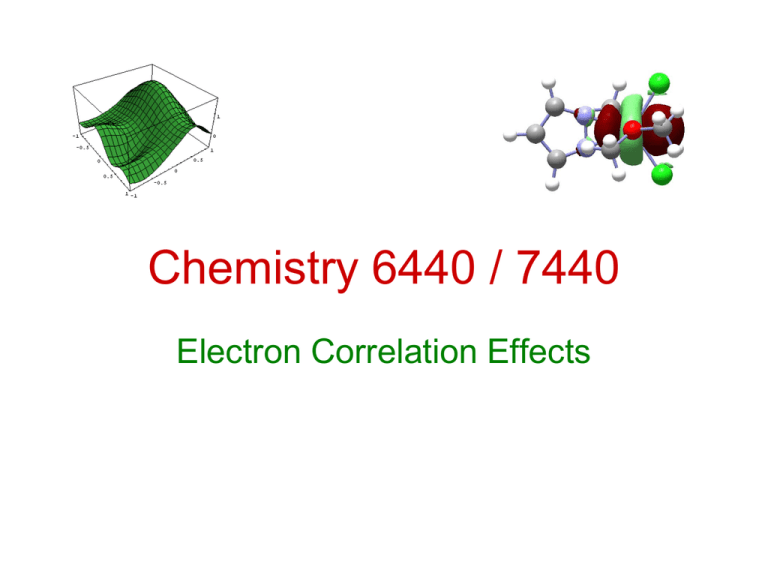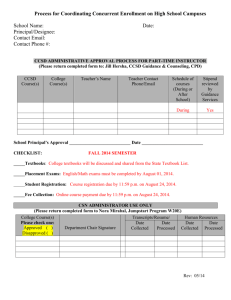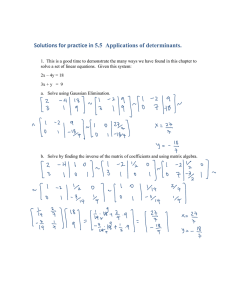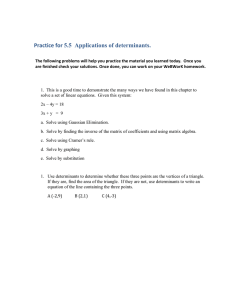Electron Corrleation
advertisement

Chemistry 6440 / 7440 Electron Correlation Effects Resources • Cramer, Chapter 7 • Jensen, Chapter 4 • Foresman and Frisch, Exploring Chemistry with Electronic Structure Methods, Chapter 6 Electron Correlation Energy • in the Hartree-Fock approximation, each electron sees the average density of all of the other electrons • two electrons cannot be in the same place at the same time • electrons must move two avoid each other, i.e. their motion must be correlated • for a given basis set, the difference between the exact energy and the Hartree-Fock energy is the correlation energy • ca 20 kcal/mol correlation energy per electron pair General Approaches • include r12 in the wavefunction – suitable for very small systems – too many difficult integrals – Hylleras wavefunction for helium • expand the wavefunction in a more convenient set of many electron functions – Hartree-Fock determinant and excited determinants – very many excited determinants, slow to converge – configuration interaction (CI) Goals for Correlated Methods • well defined – applicable to all molecules with no ad-hoc choices – can be used to construct model chemistries • efficient – not restricted to very small systems • variational – upper limit to the exact energy • size extensive – E(A+B) = E(A) + E(B) – needed for proper description of thermochemistry • hierarchy of cost vs. accuracy – so that calculations can be systematically improved Configuration Interaction 0 tia ia tijab ijab ia ijab abc abc t ijk ijk ijkabc 0 | 1 n | reference determinan t (Hartree - Fock wavef unction) ia | 1 i 1ai 1 n | singly excited determinan t (excite occupied orbital i to unoccupied orbital a ) ijab | 1 i 1ai 1 j 1b j 1 n | doubly excited determinan t (i a , j b ) etc. Configuration Interaction • determine CI coefficients using the variational principle 0 tia ia tijab ijab ia ijab abc abc t ijk ijk ijkabc ˆ d / *d with respect to t minimize E *H • CIS – include all single excitations – useful for excited states, but on for correlation of the ground state • CISD – include all single and double excitations – most useful for correlating the ground state – O2V2 determinants (O=number of occ. orb., V=number of unocc. orb.) • CISDT – singles, doubles and triples – limited to small molecules, ca O3V3 determinants • Full CI – all possible excitations – ((O+V)!/O!V!)2 determinants – exact for a given basis set – limited to ca. 14 electrons in 14 orbitals Configuration Interaction Ht Et • very large eigenvalue problem, can be solved iteratively • only linear terms in the CI coefficients • upper bound to the exact energy (variational) • appliciable to excited states • gradients simpler than for non-variational methods Size Extensivity • E(A+B) =E(A)+E(B) for two systems at long distance • CID for helium with 2 basis functions 0 t A12A1A2A A • two helium’s calculated separately – E=E(A)+E(B), = AB (0 A t A 12A1A2A A )( 0 B t B 12BB1B2 B ) 0 t A tB t At B • CID for two helium’s at long distance (no quadruply excited determinant) 2 A2 A 2B 2B 0 t A1A1A t B 1B1B 2 A2 A 1A1A 2B2B 1B1B 2 A2 A2 B 2 B 1A1A1B1B Perturbation Theory • divide the Hamiltonian into an exactly solvable part and a perturbation ˆ E H ˆ 0 E 00 H ˆ H ˆ V ˆ H 0 i i i 0 • expand the Hamiltonian, energy and wavefunction in terms of l ˆ H ˆ lV ˆ E E lE l2 E l l2 H 0 0 1 2 0 1 2 • collect terms with the same power of l ˆ E H 0 0 0 0 ˆ V ˆ E E E V ˆ d H 0 1 0 0 1 1 0 1 ˆ V ˆ E E E H 0 2 1 0 2 1 1 2 0 0 0 ˆ d E2 0 V 1 Møller-Plesset Perturbation Theory • choose H0 such that its eigenfunctions are determinants of molecular orbitals ˆ Fˆ H 0 i • expand perturbed wavefunctions in terms of the Hartree-Fock determinant and singly, doubly and higher excited determinants 1 aia ia aijab ijab ia ijab abc abc a ijk ijk ijkabc • perturbational corrections to the energy ˆ d V ˆ d EHF E0 E1 0 H 0 0 0 0 ˆ d E EMP 2 EHF E2 EHF 0 V 1 HF i j , a b ˆ ab d ]2 [ 0 V ij a a i j Møller-Plesset Perturbation Theory • size extensive at every order • MP2 - second order relatively cheap (requires only double excitations) • 2nd order recovers a large fraction of the correlation energy when Hartree-Fock is a good starting point • practical up to fourth order (single, doubly, triple and quadruple excitations) • MP4 order recovers most of the rest of the correlation energy • series tends to oscillate (even orders lower) • convergence poor if serious spin contamination or if Hartree-Fock not a good starting point Coupled Cluster Theory • CISD can be written as ˆ T ˆ ) CISD (1 T 1 2 0 • T1 and T2 generate all possible single and double excitations with the appropriate coefficients T̂2 0 ab ab t ij ij i j , a b • coupled cluster theory wavefunction ˆ T ˆ ) CCSD exp(1 T 1 2 0 Coupled Cluster Theory • CCSD energy and amplitudes can be obtained by solving ˆ E ) d 0 ( H CC CC 0 ˆ E ) d 0 ( H CC CC a i ˆ E ) d 0 ( H CC CC ab ij Coupled Cluster Theory • • • • • CC equations quadratic in the ampitudes must be solve iteratively cost of each iteration similar to MP4SDQ CC is size extensive CCSD - single and double excitations correct to infinite order • CCSD - quadruple excitations correct to 4th order • CCSD(T) - add triple excitations by pert. theory • QCISD – configuration interaction with enough quadratic terms added to make it size extensive (equivalent to a truncated form of CCSD)




